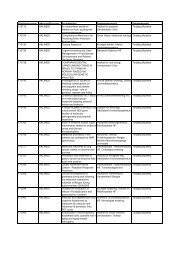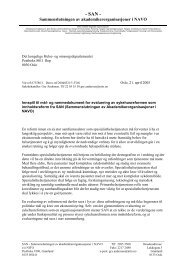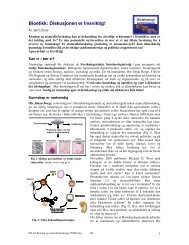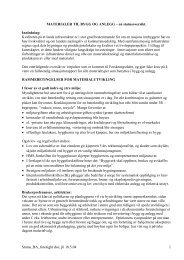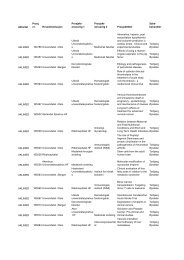A Revolution in R&D
A Revolution in R&D
A Revolution in R&D
Create successful ePaper yourself
Turn your PDF publications into a flip-book with our unique Google optimized e-Paper software.
Realiz<strong>in</strong>g this value is a matter not only of market<br />
dynamics, but also of various more speculative factors:<br />
how acceptable pharmacogenetics will prove<br />
to payers, patients, physicians, and regulatory agencies;<br />
how readily physicians and patients will<br />
embrace the screen<strong>in</strong>g tests to generate share shift;<br />
and so on. So the different types of pharmacogenetics<br />
will probably come <strong>in</strong>to effect at different<br />
times. Detection of rare side effects will probably be<br />
<strong>in</strong>troduced first, as pharmaceutical companies are<br />
highly motivated to save drugs from failure. Efficacy<br />
pharmacogenetics will probably progress on a<br />
slower timetable, ow<strong>in</strong>g to concerns about market<br />
fragmentation. It might even take FDA action to<br />
turn efficacy test<strong>in</strong>g <strong>in</strong>to a rout<strong>in</strong>e procedure.<br />
When contemplat<strong>in</strong>g their pharmacogenetics policy,<br />
companies will need to scrupulously analyze<br />
specific drugs and markets. Decid<strong>in</strong>g shrewdly just<br />
where and when to apply pharmacogenetics, for<br />
<strong>in</strong>stance, will mean assess<strong>in</strong>g market dynamics earlier<br />
than ever before <strong>in</strong> the cl<strong>in</strong>ical trials phase. And<br />
that <strong>in</strong> turn will demand new decision-mak<strong>in</strong>g<br />
processes and communication channels, <strong>in</strong>clud<strong>in</strong>g<br />
stronger ties between research and development,<br />
and between R&D and commercial activities. It is<br />
on operational and organizational issues of this<br />
k<strong>in</strong>d that the spotlight will fall <strong>in</strong> the next chapter<br />
of this report.<br />
A F<strong>in</strong>al Word<br />
If the new genetics can realize its full potential, the<br />
economics of pharmaceutical R&D will undergo a<br />
metamorphosis. Efficiency will improve handsomely<br />
and success rates will surge. The sums saved<br />
could exceed a half billion dollars per drug, more<br />
than halv<strong>in</strong>g the current cost.<br />
That prospect is far from assured. There are<br />
enough risks and uncerta<strong>in</strong>ties to temper excite-<br />
ment. The range of possible outcomes is wide, and<br />
companies will have to exam<strong>in</strong>e m<strong>in</strong>utely and apply<br />
selectively the various genetics opportunities.<br />
Contrast genomics technology: the productivity<br />
improvements promised by its implementation may<br />
be more modest, but they are clearly achievable,<br />
despite the operational challenges. With genetics,<br />
the operational challenges are formidable too, but<br />
they are compounded by less dist<strong>in</strong>ct and possibly<br />
more <strong>in</strong>tractable challenges: technological limitations,<br />
scientific unknowns, and (<strong>in</strong> the case of pharmacogenetics)<br />
the vagaries of the marketplace.<br />
So, companies determ<strong>in</strong>ed to acquire and exploit<br />
genetic <strong>in</strong>formation need to know what they are lett<strong>in</strong>g<br />
themselves <strong>in</strong> for. They need to consider how<br />
applicable genetics is to their current research<br />
strategy. They need to spell out the level of risk they<br />
are prepared to take on, and then plan how to manage<br />
that risk. In short, they need a genetics strategy.<br />
In the case of disease genetics, risk management<br />
would best beg<strong>in</strong> by contemplat<strong>in</strong>g the sheer magnitude<br />
of the undertak<strong>in</strong>g. Companies will be<br />
prompted to ask themselves questions such as these:<br />
How feasible is it for us to establish an extensive<br />
disease genetics program <strong>in</strong>-house? On which diseases<br />
should our program focus? Are there opportunities<br />
to share the risk, perhaps by jo<strong>in</strong><strong>in</strong>g a “precompetitive”<br />
<strong>in</strong>dustry consortium, along the l<strong>in</strong>es<br />
of the SNP Consortium? Or, should we adopt a waitand-see<br />
stance, and then hope to license <strong>in</strong> the<br />
fruits of others’ labor?<br />
In the case of pharmacogenetics, risk management<br />
beg<strong>in</strong>s by reevaluat<strong>in</strong>g the pipel<strong>in</strong>e. On that basis,<br />
companies will try to determ<strong>in</strong>e the drugs to which<br />
pharmacogenetics applications would add most<br />
value. Companies will also want to study <strong>in</strong>tently the<br />
market context and competitor landscape, th<strong>in</strong>k<strong>in</strong>g<br />
through potential competitor moves and counter-<br />
39



